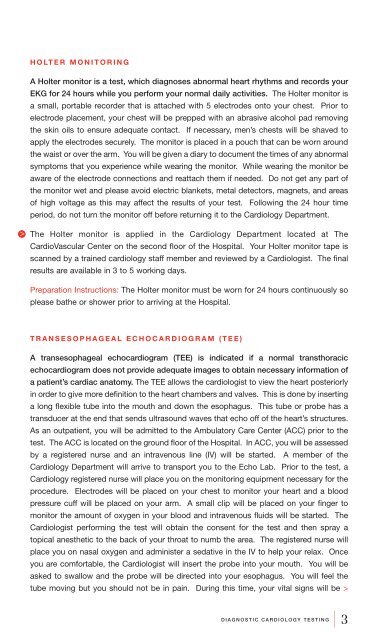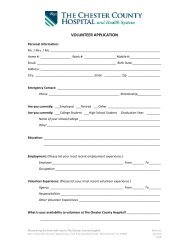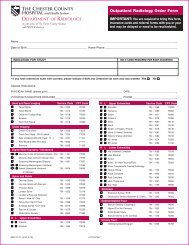Diagnostic Testing - The Chester County Hospital
Diagnostic Testing - The Chester County Hospital
Diagnostic Testing - The Chester County Hospital
Create successful ePaper yourself
Turn your PDF publications into a flip-book with our unique Google optimized e-Paper software.
HOLTER MONITORINGA Holter monitor is a test, which diagnoses abnormal heart rhythms and records yourEKG for 24 hours while you perform your normal daily activities. <strong>The</strong> Holter monitor isa small, portable recorder that is attached with 5 electrodes onto your chest. Prior toelectrode placement, your chest will be prepped with an abrasive alcohol pad removingthe skin oils to ensure adequate contact. If necessary, men’s chests will be shaved toapply the electrodes securely. <strong>The</strong> monitor is placed in a pouch that can be worn aroundthe waist or over the arm. You will be given a diary to document the times of any abnormalsymptoms that you experience while wearing the monitor. While wearing the monitor beaware of the electrode connections and reattach them if needed. Do not get any part ofthe monitor wet and please avoid electric blankets, metal detectors, magnets, and areasof high voltage as this may affect the results of your test. Following the 24 hour timeperiod, do not turn the monitor off before returning it to the Cardiology Department.><strong>The</strong> Holter monitor is applied in the Cardiology Department located at <strong>The</strong>CardioVascular Center on the second floor of the <strong>Hospital</strong>. Your Holter monitor tape isscanned by a trained cardiology staff member and reviewed by a Cardiologist. <strong>The</strong> finalresults are available in 3 to 5 working days.Preparation Instructions: <strong>The</strong> Holter monitor must be worn for 24 hours continuously soplease bathe or shower prior to arriving at the <strong>Hospital</strong>.TRANSESOPHAGEAL ECHOCARDIOGRAM (TEE)A transesophageal echocardiogram (TEE) is indicated if a normal transthoracicechocardiogram does not provide adequate images to obtain necessary information ofa patient’s cardiac anatomy. <strong>The</strong> TEE allows the cardiologist to view the heart posteriorlyin order to give more definition to the heart chambers and valves. This is done by insertinga long flexible tube into the mouth and down the esophagus. This tube or probe has atransducer at the end that sends ultrasound waves that echo off of the heart’s structures.As an outpatient, you will be admitted to the Ambulatory Care Center (ACC) prior to thetest. <strong>The</strong> ACC is located on the ground floor of the <strong>Hospital</strong>. In ACC, you will be assessedby a registered nurse and an intravenous line (IV) will be started. A member of theCardiology Department will arrive to transport you to the Echo Lab. Prior to the test, aCardiology registered nurse will place you on the monitoring equipment necessary for theprocedure. Electrodes will be placed on your chest to monitor your heart and a bloodpressure cuff will be placed on your arm. A small clip will be placed on your finger tomonitor the amount of oxygen in your blood and intravenous fluids will be started. <strong>The</strong>Cardiologist performing the test will obtain the consent for the test and then spray atopical anesthetic to the back of your throat to numb the area. <strong>The</strong> registered nurse willplace you on nasal oxygen and administer a sedative in the IV to help your relax. Onceyou are comfortable, the Cardiologist will insert the probe into your mouth. You will beasked to swallow and the probe will be directed into your esophagus. You will feel thetube moving but you should not be in pain. During this time, your vital signs will be >DIAGNOSTIC CARDIOLOGY TESTING| 3
















